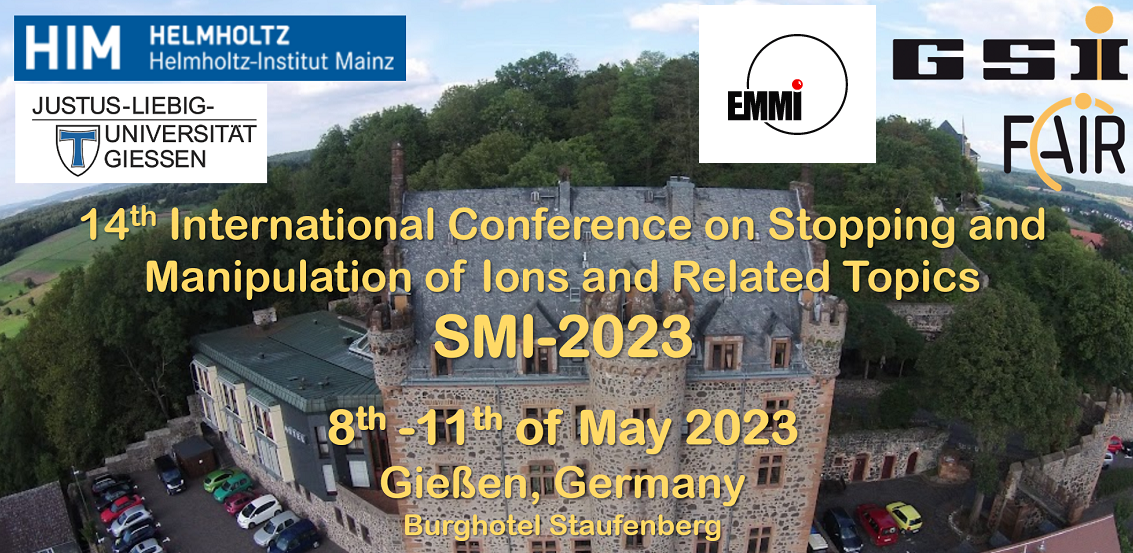Sprecher
Beschreibung
In the Fragment Separator (FRS) at GSI, exotic nuclei are produced by projectile fragmentation and fission at relativistic energies, separated in-flight and range-bunched. For many experiments the nuclei have to be slowed down from relativistic energies to a few eV and thermalized. At the FRS Ion Catcher experiment, this is realized with a cryogenic gas-filled stopping cell (CSC). After the ions have been stopped and extracted from the CSC, they are guided through the gas filled RFQ beam line to a multiple-reflection time-of-flight mass spectrometer (MR-TOF-MS) for high precision mass measurements or isobar and isomer separation. In order to widen the range of measurable nuclei with shorter half-lives and be able to cope with higher beam intensities, some technical improvements had to be implemented. The CSC needs to be able to handle high incoming ion rates, for this purpose a special, shortened DC-electrode configuration was installed in the CSC, providing also the advantage to reduce the extraction time. On the other hand, the MR-TOF-MS has to run with high repetition rate yielding short cycle times and thus rendering very short-lived exotic nuclei to be experimentally accessible before their decay. Additionally, measurements with high repetition rates also result in a higher rate capability for the MR-TOF-MS, getting rid of the interactions between the ions (space-charge effects) and reducing the number of events detected under dead-time conditions.
In this poster, the dedicated technical improvements to achieve higher rate capability and higher repetition rate will be shown together with preliminary results.
Collaboration group: TORTORELLI, Nazarena (LMU, Munich, Germany and GSI Helmholtzzentrum für Schwerionenforschung, Darmstadt, Germany); AMANBAYEV, D. (JLU Gießen, Germany); AYET, S. (GSI Helmholtzzentrum für Schwerionenforschung, Darmstadt, Germany); BECK, S. (JLU Gießen, Germany); BERGMANN, J. (JLU Gießen, Germany); BRENCIC, Z. (Jozef Stefan Institute, Ljubljana, Slovenia); CONSTANTIN, P. (Extreme Light Infrastructure Nuclear Physics, Horia Hulubei National Institute for R & D in Physics and Nuclear Engineering, Bucharest-Magurele, Romania); DICKEL, T. (GSI Helmholtzzentrum für Schwerionenforschung, Darmstadt, Germany and JLU Gießen, Germany); GRÖF, L. (JLU Gießen, Germany); KRIPKO KONCZ, G. (JLU Gießen, Germany); MARDOR, I. (Soreq Nuclear Research Center, 8180000, Yavne, Israel and Doctoral School in Engineering and Applications of Lasers and Accelerators, University Polytechnica of Bucharest, Bucharest, Romania); NARANG, M. (GSI Helmholtzzentrum für Schwerionenforschung, Darmstadt, Germany); POHJALAINEN, I. (University of Jyväskylä, Finland); PLAß, W. R. (GSI Helmholtzzentrum für Schwerionenforschung, Darmstadt, Germany and JLU Gießen, Germany); REITER, M. P. (University of Edinburgh, UK); ROTARU, A. (Extreme Light Infrastructure Nuclear Physics, Horia Hulubei National Institute for R & D in Physics and Nuclear Engineering, Bucharest-Magurele, Romania and Doctoral School for Applied Sciences, University Polytechnica of Bucharest, Bucharest, Romania); SCHEIDENBERGER, C. (GSI Helmholtzzentrum für Schwerionenforschung, Darmstadt, Germany and JLU Gießen, Germany); THIROLF, P. (LMU Munich,Germany); YU, J. (GSI Helmholtzzentrum für Schwerionenforschung, Darmstadt, Germany); ZHAO, J. (GSI Helmholtzzentrum für Schwerionenforschung, Darmstadt, Germany and Peking University, Beijing, China).
Presenter: TORTORELLI, Nazarena (Ludwig-Maximilians-University Munich and GSI)
Comments:
This abstract is addressed for a poster session, it is not for a talk.

